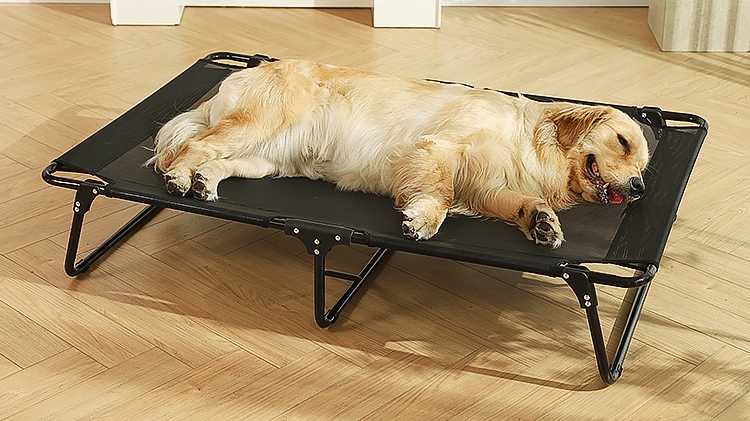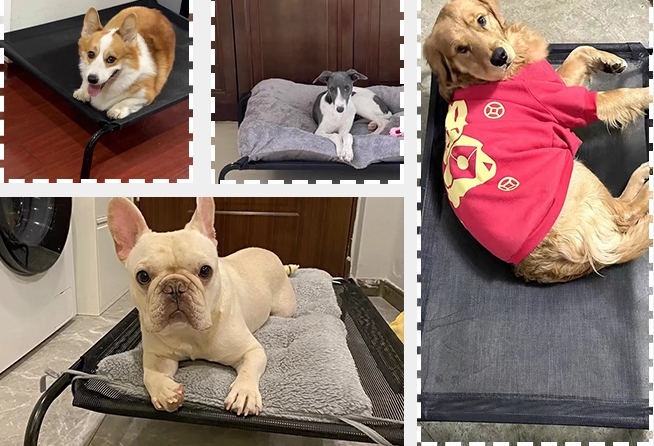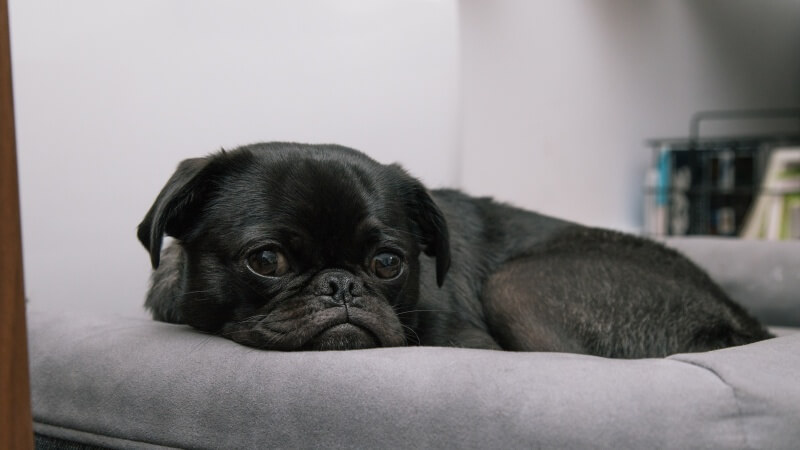
Diy PVC Dog Bed:A Mini Guide
DIY PVC dog bed is a wonderful way to show appreciation to your canine companions, who are undeniably man’s best friends. These loyal pets provide

Choosing an elevated dog bed made with high-quality, durable materials ensures it will last for years while withstanding daily use. The right construction materials make a big difference in strength, longevity, and performance.
Consider these top material options when shopping for an elevated dog bed built to go the distance.
Powder-coated steel is one of the toughest, most durable metals used in elevated dog bed frames. The powder coating process involves applying colored powdered paint electrostatically to the steel before baking it to form a protective finish. This treatment prevents rust, chips, and corrosion.
Powder-coated steel frames offer superior sturdiness and unmatched longevity perfect for active dogs.
The powder coating process starts with the steel going through a cleansing pretreatment to remove any contaminants. Next, the electrostatic sprayer applies a uniform coat of colored powdered polymer resin.
When the powder coating particles make contact with the grounded steel frame, they gain a negative charge that creates a strong electrostatic bond. The entire frame gets evenly coated inside and out.
Finally, the powder-coated frame goes into a high-temperature oven to cure and fuse the powder into a smooth, durable, protective finish. This baked-on coating is much thicker and tougher than conventional paint.
To keep a powder-coated steel dog bed frame looking like new:
With proper care, a powder-coated steel elevated bed will maintain its integrity and luster for many years. The tough coated finish resists fading, yellowing, and scratches.

Wrought iron is a popular sturdy metal for elevated dog beds. It has a high concentration of glassy iron carbides in its metallurgical microstructure. This gives it the flexibility to resist denting and deforming.
Beautiful and brawny, wrought iron crafts elevated beds built to last.
Wrought iron gets its legendary strength and durability from its unique molecular composition. During the manufacturing process, melted iron is mixed with glassy carbon particles called slag. These trapped slag inclusions make wrought iron more elastic and corrosion-resistant compared to cast iron.
The fibers of slag reinforce the iron, preventing cracks from spreading. This gives wrought iron beds the ability to flex without breaking while resisting dents. Even after centuries outdoors, wrought iron maintains its mighty durability.
A wrought iron elevated dog bed requires minimal maintenance:
With its unyielding strength, wrought iron will deliver decade after decade of reliable performance. This classy material stays beautiful and supportive for dogs to enjoy.
From aircraft to laptops, aluminum’s durability, strength, and lightweight properties make it popular across industries, including pet beds. Aircraft-grade aluminum offers the same benefits as a canine-approved bed.
Aircraft-grade aluminum delivers ultra-toughness in an easy-to-handle elevated frame.
Aircraft-grade aluminum contains specific alloy mixtures tailored for aviation use. Alloys like 6061 and 7075 offer optimal combinations of weldability, corrosion resistance, and strength for plane construction.
The same reasons that make these alloys ideal for the demands of aircraft also make them perfect for crafting nearly indestructible elevated dog beds:
From soaring through the skies to supporting your best friend, aircraft-grade aluminum excels at durability.
To maintain an elevated bed with an aircraft-grade aluminum frame:
With careful use, aircraft-grade aluminum provides a straight-as-an-arrow foundation able to withstand your dog’s demands.
Hardwoods like oak, maple, and ash provide gorgeous elegance and sturdiness for elevated dog beds. Their dense grain makes hardwood highly resistant to scratches, gouges, and dents.
Hardwoods craft elevated beds with heirloom-quality longevity and charm.
Hardwoods get their resilience from the structure of their close-knit grain and dense cellulose fibers. The tight growth rings result in a heavy, robust board. This gives hardwoods incredible hardness ratings.
Oak rates 1,220 lbs on the Janka hardness scale. Maple is 1,450 lbs. These figures indicate the force needed to embed a steel ball halfway through a wood sample. The higher the number, the harder the wood. No wonder hardwoods stand up so well to years of dog use!
To help a hardwood elevated bed frame stand the test of time:
With proper maintenance, the natural beauty and brown of hardwoods will last through many dog generations.
For added toughness, some steel dog beds are coated in a protective layer of epoxy resin. The epoxy sealant adheres to the steel, forming a barrier that resists corrosion.
Epoxy turns tough steel into an even tougher elevated bed frame material.
Epoxy coatings protect the underlying steel through the properties of epoxy resin. After getting mixed and catalyzed, the liquid epoxy gets applied to the steel where it flows and self-levels.
As it cures, the epoxy undergoes cross-linking to form a plastic polymer coating bonded at a molecular level to the steel. This impenetrable shield keeps moisture and oxygen from reaching the metal.
The slick surface also resists scratching, fading, and staining. Epoxy literally seals and preserves the pristine state of steel.
To help an epoxy-coated elevated bed frame maintain its durability:
With an epoxy shield locking in its integrity, a steel elevated bed gains long-lasting luster and strength.

Special heavy-duty polymers designed for marine environments make excellent elevated bed materials. They resist UV rays, rust, corrosion, and humidity without degrading.
Marine-grade polymers create versatile elevated beds suitable for indoor and outdoor use.
Polymer materials engineered specifically to withstand ocean use are perfect for elevated dog beds. Marine-grade plastics are formulated with:
A marine-grade polymer bed retains its integrity, whether used dockside or in your living room.
To keep a marine-grade polymer bed performing:
With proper maintenance, marine-grade polymer maintains its strength and looks for season after season of faithful service.
For a budget-friendly but still durable option, look for PVC elevated beds with reinforced wall thickness. The extra-thick PVC plastic provides enhanced strength and structure.
Thick PVC plastic is studied but flexible
Reinforced PVC offers reliable durability at a lower cost.
Standard PVC sheets used in furniture and construction are typically 1/8″ to 1/4″ thick. But reinforced PVC dog beds use panels ranging from 1/2″ to 3/4″ thick. Some beds even use 1″ thick sheets on key load-bearing walls.
In addition, quality PVC beds beef up the joints where panels connect. Plastic gussets, corner brackets, or interlocking panels make the joints stronger.
Thicker sheets paired with reinforced joints result in an elevated PVC bed with enhanced ruggedness built to handle active dogs.
To keep a reinforced PVC bed in good condition:
Even economical PVC can deliver durable performance when properly reinforced and cared for.
This hybrid combination takes advantage of both metal and plastic. The powder-coated steel tubing frame provides rigidity while the plastic-injected joints offer durability.
It merges the best aspects of steel frames with reinforced plastic.
This mixed material approach fuses tubular steel with molded polyethylene plastic connectors. The high-density polyethylene (HDPE) gets injected into precision molds to create the specially shaped joints.
HDPE provides impact resistance, strength, and weather ability. The joints easily pop onto the powder-coated steel tubes to create a sturdy supportive structure.
The frame remains securely interconnected while retaining flexibility without falling apart. The steel adds strength while the HDPE prevents joints from wearing out.
To maintain a steel and plastic elevated bed frame:
This mixed material combo merges the benefits of both heavy-duty steel and resilient polyethylene plastic.
For an upscale duo, aircraft-grade aluminum paired with rich acacia wood makes a posh elevated bed. The materials complement each other for sturdiness and beauty.
This pairing brings together robust metals with natural wood grains.
This elite combination takes advantage of both materials’ attributes:
The aircraft-grade aluminum provides:
Together they create a high-end bed as robust as it is beautiful.
To maintain the beauty and performance of this duo:
With occasional care, the aluminum and acacia duo will retain their visual appeal and performance.

Steel tubes coated in powder paired with durable marine canvas make a super strong duo. It couples heavy-duty frames with weatherproof, resilient fabric.
This pairing brings together the ruggedness of steel with the waterproofness of marine canvas:
In harmony, the materials craft an elevated bed ready for indoor relaxing or outdoor adventures.
To maintain a powder-coated steel and marine canvas elevated bed:
Properly cared for, this winning combination of ultra-tough steel and water-resistant marine canvas stands up to heavy use indoors and out for many years. With routine maintenance and cleaning, the materials maintain their integrity and performance.
Keep these factors in mind when assessing an elevated bed’s durability:
Thoroughly examining the materials, construction, specs, and reviews will reveal whether an elevated bed is built from quality durable materials or flimsily fabricated. Choosing the most rugged heavy-duty materials gives your dog a bed built to last.
For notorious canine chewers, an elevated bed must be chew-proof. Look for these chewing deterrents:
For the most destructive chewers, elevated beds must be fabricated from the toughest, most chew-resistant materials to maintain their integrity. Finding a bed rated for the chewing breed can mean the difference between a destroyed bed and one that holds up for the long term.
Elevated dog beds designed for larger breeds should have a higher weight limit rating. Pick a bed with a capacity well above your dog’s current and projected adult weight. Exceeding these limits risks compromised structural integrity.
A properly weight-rated bed ensures the materials and construction can withstand years of daily use without sagging, bending or deterioration. An undersized bed not designed for larger loads can collapse or break much quicker.

To maximize the lifespan of your elevated dog bed and materials, perform regular maintenance:
With regular inspections, cleaning, and maintenance, a quality elevated dog bed will withstand your dog’s demands for many years while retaining its aesthetic appeal. Follow material care recommendations and treat gently for optimal performance and longevity.
Conclusione
Today’s most durable elevated dog beds feature incredibly resilient construction from powder-coated steel to marine-grade PVC. Choosing long-lasting structural materials like aircraft aluminum, reinforced polymers, and weatherproof fabrics crafts an elevated bed able to handle serious wear, outdoor conditions, and active dogs.
Carefully examine the frame, fabric, fasteners, and coatings used in any bed under consideration. Pick a design made with rigorously tested, high-quality materials so your dog’s bed maintains its integrity and performance for years of cherished use.


DIY PVC dog bed is a wonderful way to show appreciation to your canine companions, who are undeniably man’s best friends. These loyal pets provide

When it comes to ensuring your pet’s comfort, the choice of a dog elevated bed can make a significant difference. In this blog, we delve

The moment you think of a dog elevated bed, the question arises: is it more suitable for a Great Dane or a Chihuahua? This blog

In the quest for the perfect dog elevated bed, pet owners are often faced with a dilemma: foldable or fixed? Each type offers unique benefits,

DIY PVC dog bed is a wonderful way to show appreciation to your canine companions, who are undeniably man’s best friends. These loyal pets provide

When it comes to ensuring your pet’s comfort, the choice of a dog elevated bed can make a significant difference. In this blog, we delve

The moment you think of a dog elevated bed, the question arises: is it more suitable for a Great Dane or a Chihuahua? This blog

In the quest for the perfect dog elevated bed, pet owners are often faced with a dilemma: foldable or fixed? Each type offers unique benefits,
Copyright © 2024 skyrestelevateddogbed. All Rights Reserved.